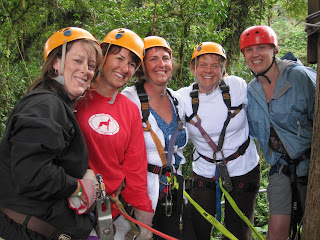Here is the link to the Biome Detective poster on the Fund For Teachers website:
http://www.fundforteachers.org/tpsreports/final/Wisconsin%20Program/670.pdf
Tuesday, October 19, 2010
Monday, July 12, 2010
Pura Vida!
Palo Verde National Park
 This is a termite nest we saw entering into Palo Verde National Park. Nests are very common in many of the trees throughout Costa Rica.
This is a termite nest we saw entering into Palo Verde National Park. Nests are very common in many of the trees throughout Costa Rica. These are fairly small bats. They hang in a line to camouflage themselves from predators.
These are fairly small bats. They hang in a line to camouflage themselves from predators. This crocodile is coming near our boat because he could smell the raw chicken we were about to feed it. The crocodile moved slowly and cautiously through the water. The water appears brown but is not polluted, the bottom is muddy.
This crocodile is coming near our boat because he could smell the raw chicken we were about to feed it. The crocodile moved slowly and cautiously through the water. The water appears brown but is not polluted, the bottom is muddy.Friday, July 2, 2010
Sunset in Costa Rica


We stayed on the Pacific side of the country in the Guanacaste region. The beach we explored had black sand from the volcano. After our days of adventures in the rain forest we decided to enjoy a beautiful sunset from a boat a few miles off shore. We actually jumped into the ocean right as the sun was hitting the horizon. The sunset was an amazing sight and the perfect end to a day of adventure in Costa Rica.
Hummingbird Gallery

Costa Rica has 54 different species of hummingbirds. Hummingbirds do not actually hum, however the humming sound they make is created by the vibrations of their wings that flap 40-80 times per minute. They are the only bird that can fly backwards. They have an extremely high metabolism forcing them to eat twice their body weight daily. Lucky hummingbirds!
Thursday, July 1, 2010
Zip Lining in the Monte Verde Cloud Forest
 After gearing up we were ready to find out what was in store for us! We received a mini-lesson about how to keep ourselves from spinning and how to STOP!
After gearing up we were ready to find out what was in store for us! We received a mini-lesson about how to keep ourselves from spinning and how to STOP! Diane sticks her landing!
Diane sticks her landing!
Rebecca zips through the cloud forest.

After a couple of lines we stopped for a group photo. We are all smiling, but we still can't believe we're flying on wires in the middle of the rain forest in Costa Rica!
Zip lining was so much fun and we all tried it in its place of origin.....Monte Verde, Costa Rica! Zip lining originated because scientists needed a way to study the plants and animals in the rain forest. They used ropes to view and study plants and animals at all heights from ground to canopy, maneuvering themselves up and down the ropes using a wheel with teeth. These ropes weren't connected from tree to tree when it began. They would unhook themselves, move the ropes, and begin again if they wanted to see something in another tree. Scientists continue to study the rain forest for many reasons. One of the reasons is to discover plants that can be used for medicinal purposes. Scientists have discovered both penicillin and citronella in the rain forest!
Now zip lining is a great tourist attraction and an unbelievable way to get many incredible views of the scenery around you!
Zip Lining Videos
Diane and Kathy come in from our last zip line. It was the longest line and we zipped the last one with a partner. Although at times our lines zipped right through the middle of the cloud forest, this particular line kept us high above the canopy layer.
Diane
Kathy
Subscribe to:
Comments (Atom)



